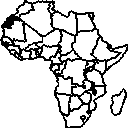Western Sahara
 The Western Sahara includes Saguiet el-Hamra in the north and
The Western Sahara includes Saguiet el-Hamra in the north and
Wadi ed Dahab (Rio de Oro) in the south.
Its area of 284 000 square Kilometers, is one tenth the size of
Algeria, half the size of France and just a little smaller
than Italy. It lies between the 20th and 30th parallel
straddling the Tropic of Cancer.
It is bordered to the north by Morocco, by Algeria to the
east, Mauritania to the south-east and the Atlantic Ocean to
the west.
As with most African states, its boundaries are the result of
agreements made among the colonial powers anxious to
safeguard their interest in the region.
In particular, they were defined in agreements made between
France and Spain in 1900, 1904 and 1912.
The topography is mostly made up of plains and some small
plateaus that rarely reach 400 meters.
On the whole, the Western Sahara can be divided into three
regions :
1) The northeast zone from the chain of Atlas mountains to the
hills of Zemmour is a rocky desert (hamadas) with steep
mountains and a pronounced relief except for a few scattered
wells.
2) The second zone is made up of rivers. It includes the wadi
Draa to the north and the Jat to the west.
These wadis are often depressions where water gathers during
the brief rainy seasons, particularly in autumn. Because of the
high temperatures the water quickly evaporated and never reaches
the sea. In this river zone flows the Saguiat el-Hamra
(the Red Canal) whose importance lends its name to the region.
Sufficient vegetation for grazing grows along its banks and at
Smara, barley and corn are cultivated.
3) The third zone, the Rio de Oro, is inland and consists of flat
plains, ergs and sand dunes.
The ground is too permeable to retain the autumn waters
and too flat to allow it to flow, hence water accumulates in
the subsoil forming numerous wells.
The inland landscape is quite monotonous and along the coast this
monotony is only broken by the peninsulas of Dakhla
(ex-Villa Cisneros) and Guera.
Inland, the climate is continental with cold, dry winters while
summers are extremely hot with temperatures reaching 60ƒ
(in the shade) and the coastal humidity causing fog, mist
and dew. Dakhla receives a yearly average rainfall of only 45
millimeters. On the coast, vegetation and flora is abundant
due to the humidity.Inland, one finds the typical flora of
the steppe and desert; some locusts along the wadis and
shrubs in the sandy depressions. To the south, there is little
fauna and to the southeast, it is mainly fennecs, antelope
and gerbils.
Information from arso

 The Western Sahara includes Saguiet el-Hamra in the north and
The Western Sahara includes Saguiet el-Hamra in the north and 